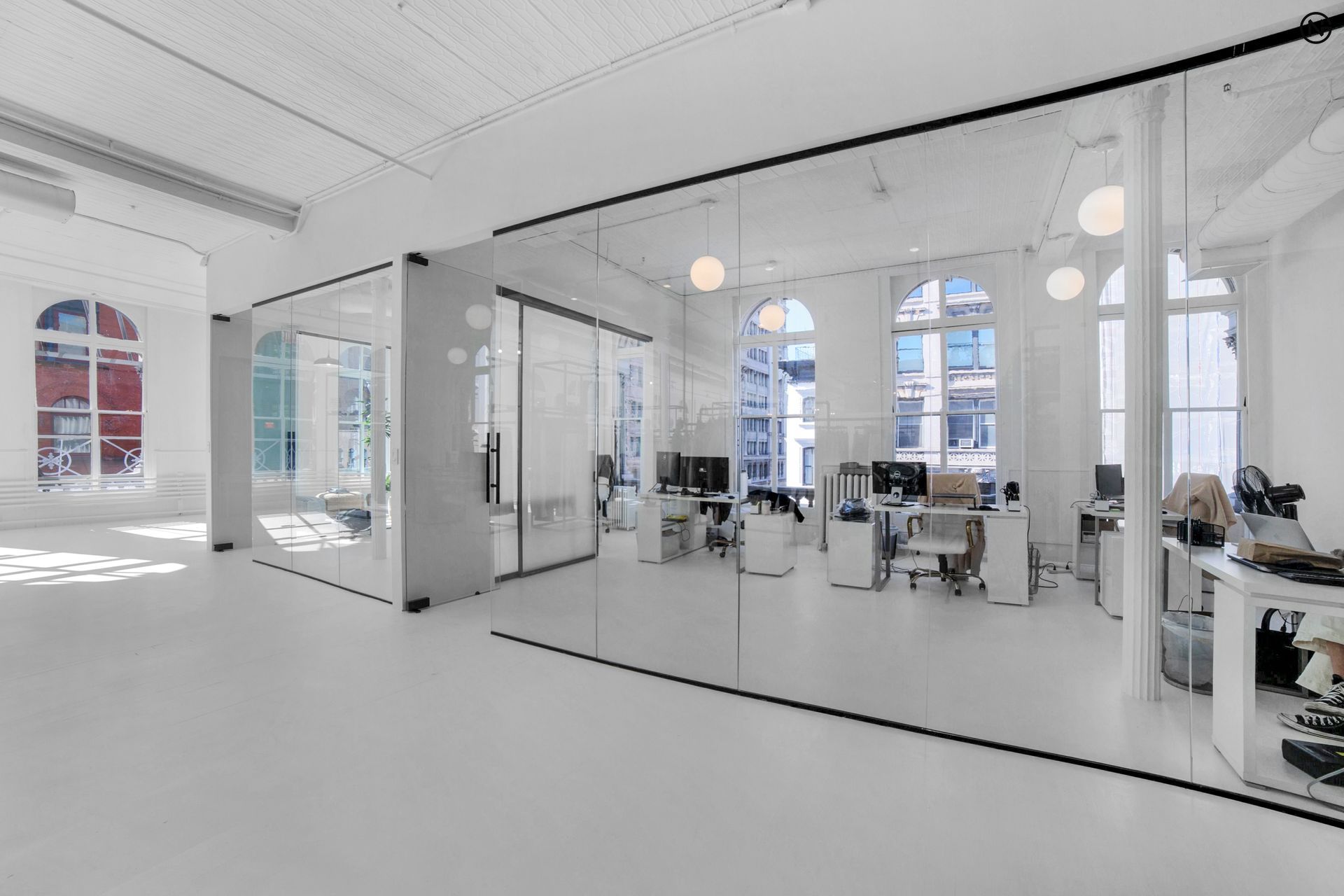NYC Office Growth: Strategic Spaces for Scaling Teams
When Spotify moved its U.S. headquarters to 4 World Trade Center, they didn’t just lease office space—they created a 564,000-square-foot ecosystem designed specifically for rapid scaling. This shift represents a broader transformation in how high-growth companies approach commercial real estate in New York City, where the right workspace strategy can accelerate growth or constrain it.

Flexible collaboration spaces define modern NYC office design for growing companies
Beyond Square Footage: The New NYC Office Equation
High-growth companies in NYC are rewriting the traditional office playbook. Rather than simply calculating headcount multiplied by square feet, today’s scaling teams factor in collaboration zones, focus pods, and flexible expansion rights. The median tech company in Manhattan now allocates 150-175 square feet per employee—down from 200+ just five years ago—but with smarter utilization.
The Three-Zone Model Taking Over NYC
- Collaboration Hubs (40% of space): Open areas with modular furniture that can shift from all-hands meetings to breakout sessions
- Deep Work Sanctuaries (35% of space): Soundproofed pods and quiet zones for focused individual work
- Social Collision Points (25% of space): Cafes, lounges, and game areas designed to spark unplanned interactions
This model emerged from NYC’s unique density challenges. Unlike Silicon Valley campuses, Manhattan offices must maximize vertical space while maintaining the energy that attracts top talent.
Neighborhood Selection: Where Growth Companies Plant Their Flags
The Migration Patterns
High-growth companies are increasingly looking beyond traditional Midtown corridors. Hudson Yards has captured 45% of tech expansions over 50,000 square feet, while Brooklyn’s Navy Yard and Dumbo have become magnets for companies in their Series A-C stages.
The calculus involves more than rent per square foot. Smart growth companies evaluate:
- Talent accessibility (average commute times for target demographics)
- Amenity density within a 5-minute walk
- After-hours vibrancy for team building
- Proximity to complementary businesses
The 15-Minute City Effect
NYC’s neighborhood-centric development means choosing the right area can reduce recruitment costs by 20-30%. Companies report that relocating to areas where their target talent already lives or socializes dramatically improves both hiring speed and retention rates.

Strategic location selection connects companies to NYC’s talent pools
Flexible Lease Strategies for Uncertain Growth Trajectories
The traditional 10-year lease doesn’t align with startup growth curves. NYC’s commercial space for rent market has adapted with innovative solutions that match the volatility of scaling businesses:
Expansion Rights and Contraction Options
Modern leases for growth companies typically include:
- Rights of First Refusal on adjacent floors
- Percentage Rent structures tied to revenue milestones
- Sublease Flexibility for pivot scenarios
- Build-to-Suit Allowances that increase with company milestones
The Hub-and-Spoke Model
Rather than committing to one large space, many high-growth companies establish a flagship location supplemented by satellite offices or coworking memberships. This allows them to test new neighborhoods before committing and provides overflow capacity during hiring surges.
Design Elements That Accelerate Company Culture
Breaking Traditional Boundaries
The fishbowl conference room is dead. Today’s growth-focused offices feature breaking out of the fishbowl designs with:
- Glass walls that transform from transparent to opaque
- Retractable partitions for instant space reconfiguration
- Stadium seating that doubles as casual meeting space
- Outdoor terraces activated year-round with heating elements
The Productivity Multiplier Effect
Data from NYC tech companies shows that thoughtful office design correlates with measurable outcomes:
- 23% increase in cross-team collaboration
- 31% reduction in meeting times (better spaces = more efficient meetings)
- 18% improvement in employee-reported focus time
- 27% boost in recruiting conversion rates during office tours
Technology Infrastructure: The Hidden Differentiator
Beyond Basic Connectivity
High-growth companies require infrastructure that traditional offices can’t provide:
- Redundant fiber connections from multiple providers
- Edge computing capabilities for real-time applications
- IoT-ready building systems for space optimization
- Touchless entry and environmental controls
The Data-Driven Office
Leading NYC offices now incorporate sensors that track:
- Space utilization patterns to optimize layouts
- Air quality and adjust HVAC in real-time
- Meeting room usage to right-size future builds
- Traffic flow to identify collaboration bottlenecks

Technology-enabled meeting spaces drive productivity in growth companies
Financial Strategies for Scaling Real Estate Costs
The 10-15% Rule
While conventional wisdom suggests keeping real estate under 10% of operating expenses, high-growth companies in NYC often invest 12-15%, viewing premium space as a talent acquisition tool. The math works when you factor in:
- Reduced recruiting costs
- Lower turnover rates
- Increased productivity
- Enhanced brand perception
Creative Financing Structures
NYC landlords now offer growth-aligned deals:
- Revenue-Based Rent: Payments scale with company revenue
- Equity Participation: Landlords take small stakes in lieu of deposits
- Graduated Schedules: Below-market early years, premium later years
Case Studies: NYC Growth Stories
Several high-growth companies have pioneered innovative approaches, as detailed in various case studies:
The Fintech Flex
A Series B fintech started with 5,000 square feet in FiDi, with options on three additional floors. As they scaled from 30 to 300 employees, they activated new floors every six months, each designed for specific functions—engineering, sales, and operations.
The Brooklyn Boom
A D2C brand chose Sunset Park over Manhattan, saving 40% on rent while creating a 25,000-square-foot headquarters that includes fulfillment space, photo studios, and traditional offices—impossible to afford in Manhattan.
Future-Proofing Your NYC Office Strategy
Anticipating 2026 and Beyond
The NYC commercial property for lease landscape continues evolving. Key trends to watch:
- Vertical Campuses: Multi-floor leases that create company neighborhoods
- Hospitality-Inspired Amenities: Concierge services, private dining, wellness centers
- Climate-Adaptive Spaces: Buildings that adjust to extreme weather events
- Metaverse Integration: Physical spaces designed for hybrid reality collaboration
The Sustainability Imperative
NYC’s Local Law 97 means buildings must reduce carbon emissions. Growth companies increasingly choose spaces with:
- LEED or WELL certifications
- Energy-efficient systems
- Sustainable materials
- Green transportation access
Making Your Move: Action Steps for High-Growth Companies
- Start Early: Begin your search 12-18 months before you need space
- Think Beyond Today: Plan for 3x your current headcount
- Prioritize Flexibility: Negotiate options and rights aggressively
- Invest in Design: Budget 15-20% of lease value for build-out
- Consider Culture: Choose neighborhoods that reflect your values
Conclusion: Space as Strategic Advantage
In NYC’s competitive talent market, office space isn’t overhead—it’s a strategic weapon. The companies winning the war for talent understand that where and how their teams work directly impacts innovation, collaboration, and growth velocity.
The right NYC office strategy can transform your company’s trajectory. Whether you’re planning your first dedicated space or scaling beyond your current footprint, the key is aligning your commercial real estate for lease decisions with your growth ambitions.
Ready to explore how the right office strategy can accelerate your company’s growth? Connect with Nomad Group to discover spaces that scale with your ambitions and attract the talent that will drive your success.
Find the perfect commercial property for lease near me and transform your workspace into a growth catalyst.
Let’s elevate your workspace—and your future.
Partner with Nomad Group for expert guidance, full-scale support and an enjoyable experience that prepares your team for a thriving future.
Get started
Featured resources
From commercial real estate fundamentals to extensive reports, stay in the know with Nomad Group’s insights, strategies and expert perspectives on office leasing.
Explore resources

Customers Over Everything: Ditch the Short-Term Profit Trap & Build Durable Growth
By Matthew DeRose – CEO, Nomad Group In hip‑hop, “Money over everything” might be a flex. In business, it’s a…

From Flex to Flagship: Knowing When to Make the Move
By Matthew DeRose – CEO, Nomad Group Coworking vs. Private Office Space: What CEOs Should Really Be Thinking About When…

